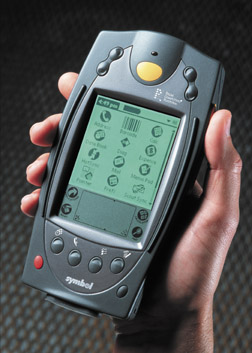

Current Cover
|
|
|
|
Symbol SPT 1700A ruggedized Palm III with laser scanner and integrated LAN radioby Conrad Blickenstorfer
June 1999 - If the world needed an other example as to why the Palm OS platform is truly special, the brand new Symbol SPT 1700 is it. Readers of this magazine will remember how impressed we were with Symbol's SPT 1500, an innovative and stylish combination of a Palm III with Symbol's own tiny SE900 laser scan engine. There were those in our editorial offices who felt the SPT 1500 was the best looking Palm device period. With the introduction of the Palm V, that may no longer be the case (though you might change your mind if you ever see one of those very rare clear plastic SPT 1500s which rate a perfect ten on the coolness scale). However, though the Palm III was specifically designed to eliminate some of the original PalmPilot's structural weaknesses, the III-and thus the SPT 1500 as well-were not designed for rough handling and use in harsh environments.
Enter the Symbol SPT 1700, a ruggedized and enhanced version of the 1500. As the photo on the righthand page cleary shows, despite its trip to boot camp the 1700 is every bit as sleek and handsome as the "civilian" 1500, and perhaps even more so. And that didn't happen by accident. When I was at Symbol's headquarter's in Holtsville, New York, I saw everything I expected from a leading manufacturer of leading edge technology. And something that I didn't expect-an industrial design lab that looked like it would be right at home at DaimlerChrysler, the acknowledged world leader of automotive design. Its director, Alistair Hamilton, gave me a detailed tour and I felt like a kid in a candy store. For inside his realm, Alistair and his able crew of designers have dreamed up-and implemented-a number of design concepts so thrilling and compelling that I spent far more than the allotted time swooning over them and peppering the assembled Symbol team with questions as to their purpose and expected availability. There weren't many answers, of course, that being a design lab where ideas are molded into possible products and sometimes simply dreams, but I don't think I'll ever see Symbol Technologies as just a maker of bar code readers and industrial terminals anymore. These boys will be BIG.
But let's get back to the SPT 1700. While it won't survive a nuclear blast, it is infinitely more sturdy and rugged than a standard Palm III or Palm III derivative. The system board, while still using Palm technology, was developed by Symbol. It is optimized for heavy duty use in vertical markets. Every single part of the SPT 1700 is beefier and sturdier, and addressing every conceivable concern a customer might have over its use in a rough environment. The center of the 1700 is a very rigid magnesium subframe which provides extra stiffness for the (Palm V-style) display mounted onto it. The motherboard is firmly mounted to the backside of the magnesium frame. This whole assembly is encased in a rugged housing of thick, reinforced plastic. The whole affair is rated to withstand the infamous four-foot drop, though the 1700 looks as if it could do even better. The housing also provides IP54 protection against entry of dust and water spray from all directions. A clear flip cover, similar to that of the Palm III, keeps dust and dirt off the screen while still providing access to the keys and buttons.
Despite all of this, the SPT 1700 feels and handles much like any other Palm device. Unlike the sometimes bewildering variety of Windows CE variants, a Palm is a Palm is a Palm. All the familiar applications are still there, and all the familiar buttons, too.
The SPT 1700 actually comes in two flavors, the batch-oriented 1700 and the wireless-LAN 1740 model. The 1740 only weighs an ounce more-10 instead of nine-even though it includes full-fledged Symbol Spectrum 24 wireless LAN functionality suitable for wireless data transfers, roaming, and paging/messaging. The 1740 also includes a Spectrum24 wireless web browser, as well as third party web clients from AvantGo and Citrix. In order to provide the necessary firepower to drive the scanner and the wireless radio, Symbol equipped both the 1700 and the 1740 with a beefy 1350mAh Li-Ion power pack on which, at least the 1700, can probably run practically forever.
As befits a vertical market product slated for duty in many different environments, Symbol offers plenty of optional add-ons. There is a single slot serial cradle (the 1700 doesn't fit into the standard Palm III cradle), 4-slot serial or Ethernet cradles/chargers, vehicle cradles, a variety of carrying and protective cases, an elastic handstrap, and a magnetic card reader attachment. Since the 1700 has what looks like a standard internal PC Card slot, customization possibilities are almost endless.
|